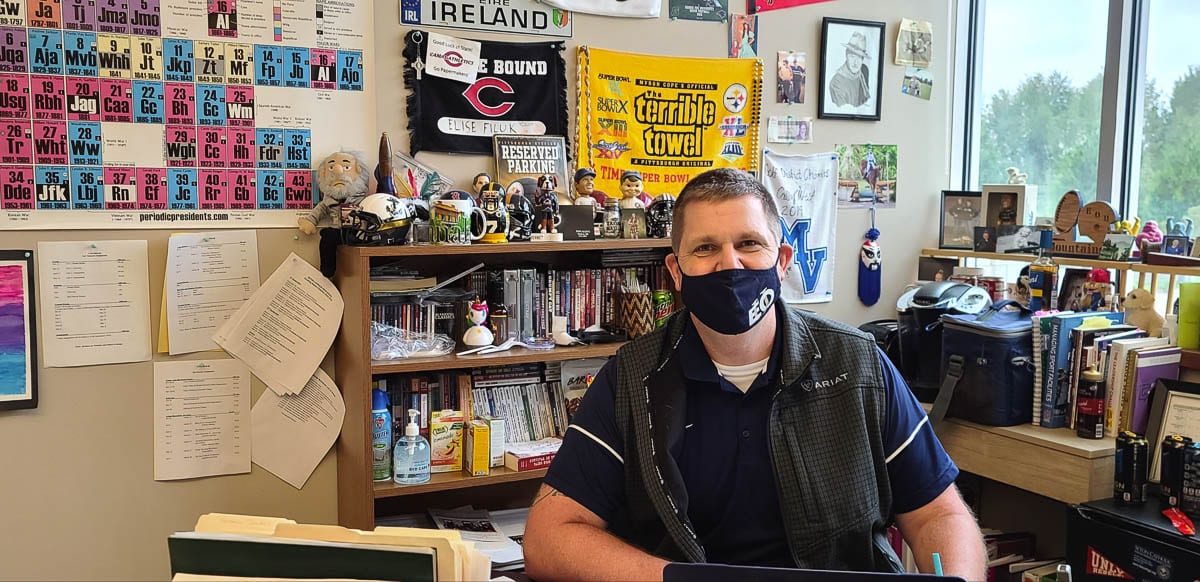Students, teachers, staff preaching safety at small, private school
The school year began with remote learning only.
Then it was time to try hybrid learning.
At first, 25 percent of the school’s students could be on campus during a day. The rest would stay home, using the remote learning system.
By the end of September, the school moved up to 50 percent of its students on campus.
So far, hybrid learning has been a success at Seton Catholic High School.

Half the students are in class, social distancing, while the others are “in class” but at home, watching and learning from the same teachers, interacting with their fellow students, all at the same time.
“You have to do it as a slow roll to ensure that it’s done right,” said Robert Rusk, the school’s principal. “We just called it our responsible reopening plan. It’s a phased approach. We’re doing things well, and now we’re just going to keep going.”
The classrooms at Seton Catholic have swivel robots, with cameras that “follow” a teacher around in the classroom. Teachers can have a conversation with a student in the classroom or a student at home.

No one is left behind.
Seton Catholic is a small, private school with roughly 200 students, but its ideas and solutions certainly could be used at bigger, public schools, Rusk said. In fact, he has already had calls from other school districts asking how Seton Catholic put together its plan.
It is believed that when most public schools return to on-campus learning, it will be a hybrid system first, with some students on campus and others still learning from home.
Initial planning for the hybrid learning model at Seton Catholic started last spring, then really picked up with input from the school’s entire community. Parents, administrators, teachers, support staff, and students. Together, they came up with a plan, with help from the Department of Health.
“It can work, it will work, as long as everyone has the same mindset and wants to make it work,” said Kasey Vu, a parent who is on the Health and Wellness Committee at the school.
That group, which includes more than 20 people with various backgrounds, met throughout the summer and continues to meet once a week, online, to go over any new challenges.
“We look at the data,” Rusk said. “Are the students following the safety procedures we have in place?”
If a problem arises, the committee is on it right away.
“We’ve gone through all the different scenarios, options, challenges, and we’ve come up with what we think is a good solution to meet all those requirements,” Vu said.
Student leaders were also part of the solutions. They were involved in helping to set up the protocols.
Students enter the school at a screening area in the gym every day. They could have filled out an online screening application prior to going to school in the morning or just do the screening at school. Temperature checks are administered, as well. All students must be cleared there before entering the hallways.
Once in the hallways, students and staff remain at least 6 feet from one another, and there are arrows on the floors directing students which way to walk. There is one stairwell that goes up and one stairwell that goes down. There is no meandering. When in the halls, a student sticks with whichever way the arrows are pointing.
Joanna and Chad Hammerstrom, parents, are on the committee as well. Chad has a medical issue that puts him at a high risk. Joanna said there is no way they would allow their daughter to go to school if they did not feel it was safe.
“In no way did we feel she was compromised in any way,” Joanna said.
As far as the committee, she said she is proud of the work it is doing to continue to ensure safety protocols. She and Chad did not have as much input in the committee as others, she said, but they appreciated being part of the process.
“I feel like we really thought of everything,” she said.
Their daughter, Hannah Jo, is a sophomore at Seton Catholic.
“I didn’t really know what to expect,” she said of that first day on campus.
The staff in the screening area, where all students arrive to school before heading to the hallways, welcomed everyone.
“That made you feel like you were back in the community,” Hannah Jo said.
“It felt so much better to be back in school than online,” she added. “Being on a computer is not the same. Being back in that community made me feel so much better.”
Still, it was awkward at first, she said, when it was only 25 percent capacity. The classroom still felt empty. It is getting better now at 50 percent.
“Seton is doing a great job,” she said. “We’re still able to be safe and see our classmates, get a good education, and still have fun at school.”
In class, the teachers have quickly adjusted to the swivel robots and hybrid system.
Kasey Powers, a social studies teacher, said he is not much of a tech guy, but he easily figured out the camera. He can teach the students in his class, and the camera is always on him for the students at home.

“It’s natural for me to do it,” he said. “I don’t even think about the camera most of the time. It’s been awesome.”
It should be noted that while Seton Catholic currently allows up to 50 percent of its students on campus, 100 percent of its students are expected to “attend” classes every day. The school separated its students into four Saint groups. When it was 25 percent on campus, one group was invited for a day, while the others stayed home. Now at 50 percent, two groups are invited to campus for a day.
The remaining students check in from home, online, watching the same classes their teachers are giving, at the same time the students on campus are hearing from the teachers.
Later in the week, the two groups that were home are invited to campus, while the other two groups stay home. The schedule is for equal access for all groups to be on campus.
Also, Rusk said, no student is required to be on campus. Any student can opt to remain home for remote learning.
The school encourages any student who is not feeling well to learn from home. The swivel cameras make that an easier decision.
“We don’t want them to feel like they are missing out on something,” Rusk said. “They’re not falling behind. It’s a seamless transition (from on-campus to remote learning).”
Still, parents, teachers, and students, for the most part, want in-building learning. That is why the Seton community stepped up to make it happen.
“We want them to go to school, obviously observing all the safety protocols,” said Vu, who has two children at the school. Rebecca is a senior. Ryan is a freshman.
“School is not just about book learning. It’s about learning how to deal with other people, and all the life skills you learn from interactions with your peers and adults,” Vu said.
The school day is shorter than traditional schooling, but that was by design, Rusk said. Fewer time on campus means a smaller chance for any transmission should there be someone on campus who is sick.
Another reason is for the students at home.
“We wanted to ensure students weren’t all day online,” Rusk said. “We don’t want students on their tablet the whole entire day. That’s just not healthy.”
The committee did come up with some extra work time for students, if needed.
At the end of each class, for example, there are 15 minutes of student support time. A student in class or online can ask teachers for extra help. But if a home student is caught up, that student gets to log off for a bit, take a break before the next class.
Also, at the end of the day, teachers are asked to remain in their classrooms, and online, for an hour to answer any questions from students.
All of this is to help Seton Catholic with one of its philosophies:
“Learning comes alive,” Rusk said.
Society’s reaction to the pandemic has made for a lot of changes. Education, though, remains essential.
Seton Catholic and its community have come up with a model that prioritizes safety as well as academics.
“It’s been successful,” Rusk said.




